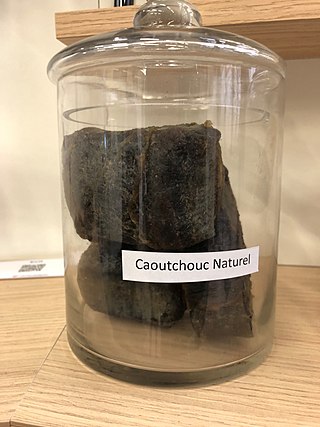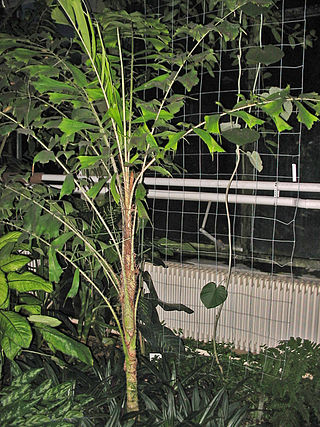
Rubber, also called India rubber, latex, Amazonian rubber, caucho, or caoutchouc, as initially produced, consists of polymers of the organic compound isoprene, with minor impurities of other organic compounds. Thailand, Malaysia, Indonesia, and Cambodia are four of the leading rubber producers.

Hevea brasiliensis, the Pará rubber tree, sharinga tree, seringueira, or most commonly, rubber tree or rubber plant, is a flowering plant belonging to the spurge family Euphorbiaceae originally native to the Amazon basin, but is now pantropical in distribution due to introductions. It is the most economically important member of the genus Hevea because the milky latex extracted from the tree is the primary source of natural rubber.

Hevea is a genus of flowering plants in the spurge family, Euphorbiaceae, with about ten members. It is also one of many names used commercially for the wood of the most economically important rubber tree, H. brasiliensis. The genus is native to tropical South America but is widely cultivated in other tropical countries and naturalized in several of them. It was first described in 1775.

Ficus elastica, the rubber fig, rubber bush, rubber tree, rubber plant, or Indian rubber bush, Indian rubber tree, is a species of flowering plant in the family Moraceae, native to eastern parts of South and Southeast Asia. It has become naturalized in Sri Lanka, the West Indies, and the US state of Florida. Despite its common names, it is not used in the commercial production of natural rubber.

Pourouma cecropiifolia is a species of Pourouma, native to tropical South America, in the western Amazon Basin in northern Bolivia, western Brazil, southeastern Colombia, eastern Ecuador, eastern Peru, and southern Venezuela.

Clusia is the type genus of the plant family Clusiaceae. Comprising 300-400 species, it is native to the Neotropics. The genus is named by Carl Linnaeus in honor of the botanist Carolus Clusius.

Aiphanes is a genus of spiny palms which is native to tropical regions of South and Central America and the Caribbean. There are about 26 species in the genus, ranging in size from understorey shrubs with subterranean stems to subcanopy trees as tall as 20 metres (66 ft). Most have pinnately compound leaves ; one species has entire leaves. Stems, leaves and sometimes even the fruit are covered with spines. Plants flower repeatedly over the course of their lifespan and have separate male and female flowers, although these are borne together on the same inflorescence. Although records of pollinators are limited, most species appear to be pollinated by insects. The fruit are eaten by several birds and mammals, including at least two species of amazon parrots.

Pouteria caimito, the abiu, is a tropical fruit tree originating in the Amazonian region of South America, and this type of fruit can also be found in the Philippines and other Southeast Asia. It grows to an average of 10 metres high, with ovoid fruits. The inside of the fruit is translucent and white. It has a creamy and jelly-like texture with a taste resembling caramel custard.

Beilschmiedia is a genus of trees and shrubs in family Lauraceae. Most of its species grow in tropical climates, but a few of them are native to temperate regions, and they are widespread in tropical Asia, Africa, Madagascar, Australia, New Zealand, North America, Central America, the Caribbean, and South America. The best-known species to gardeners in temperate areas are B. berteroana and B. miersii because of their frost tolerance. Seeds of B. bancroftii were used as a source of food by Australian Aborigines. Timbers of some species are very valuable.
Ficus maxima is a fig tree which is native to Mexico, Central America, the Caribbean and South America south to Paraguay. Figs belong to the family Moraceae. The specific epithet maxima was coined by Scottish botanist Philip Miller in 1768; Miller's name was applied to this species in the Flora of Jamaica, but it was later determined that Miller's description was actually of the species now known as Ficus aurea. To avoid confusion, Cornelis Berg proposed that the name should be conserved for this species. Berg's proposal was accepted in 2005.

Ficus insipida is a common tropical tree in the fig genus of the family Moraceae growing in forest habitats along rivers. It ranges from Mexico to northern South America.

Euphorbiaceae, the spurge family, is a large family of flowering plants. In English, they are also commonly called euphorbias, which is also the name of the type genus of the family. Most spurges, such as Euphorbia paralias, are herbs, but some, especially in the tropics, are shrubs or trees, such as Hevea brasiliensis. Some, such as Euphorbia canariensis, are succulent and resemble cacti because of convergent evolution. This family has a cosmopolitan global distribution. The greatest diversity of species is in the tropics; however, the Euphorbiaceae also have many species in nontropical areas of all continents except Antarctica.
Bagassa guianensis is a tree in the plant family Moraceae which is native to the Guianas and Brazil. It is valued as a timber tree and as a food tree for wildlife. The juvenile leaves are distinctly different in appearance from the mature leaves, and were once thought to belong to different species.
Hevea guianensis is a species of rubber tree in the genus Hevea, belonging to the family Euphorbiaceae. It is native to the rainforests of Ecuador, Venezuela, the Guyanas, Brazil, Colombia and Peru. It generally grows on well-drained soils or on those that are only lightly inundated, on river banks, in gallery forests, savannah forests and wooded slopes.
Hevea pauciflora is a species of rubber tree in the genus Hevea, belonging to the family Euphorbiaceae. It is native to the rainforests of Venezuela, the Guyanas, northern Brazil, Colombia and Peru. It grows on slopes and high river banks where it is not seasonally inundated.
Hevea rigidifolia is a species of rubber tree in the genus Hevea, belonging to the family Euphorbiaceae. It is native to the rainforests of northern Brazil and Colombia, where it is endemic to localities near the upper Rio Negro, a north bank tributary of the Amazon River, and its tributary, the Vaupés River.
Hevea spruceana is a species of rubber tree in the genus Hevea, belonging to the family Euphorbiaceae. It is native to the rainforests of northern Brazil and Guyana. It is named in honour of the English botanist Richard Spruce who spent the years 1849 to 1864 exploring the Amazon basin and sending botanical specimens back to Europe.
Hevea benthamiana is a species of rubber tree in the genus Hevea, belonging to the family Euphorbiaceae. A medium-sized deciduous tree growing to a height of about 27 m (90 ft), it is native to the rainforests of northern Brazil, Colombia and Venezuela.
Hevea microphylla is a species of rubber tree in the genus Hevea, belonging to the family Euphorbiaceae. It is native to the Amazon basin where it occurs in Venezuela, Colombia and northern Brazil. It was first described in 1905 by the German botanist Ernst Heinrich Georg Ule. It is the only member of the genus to be included in the subgenus Microphyllae.
Hevea camargoana is a species of flowering plant in the genus Hevea, the rubber trees, belonging to the family Euphorbiaceae. It is native to the island of Marajó in the Amazon delta in northeastern Brazil where it was discovered in 1975. It is a small tree and Its typical habitat is dry savannah and woodland bordering seasonally inundated swamps.









